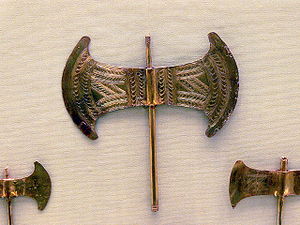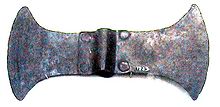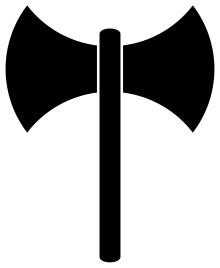- Labrys
-
Labrys (λάβρυς in Greek, lábrys) is the term for a symmetrical doubleheaded axe originally from Crete in Greece, one of the oldest symbols of Greek civilization; to the Romans, it was known as a bipennis.[1]
The double-bitted axe remains a forestry tool to this day,[2] and the labrys certainly functioned as a tool and hewing axe[3] before it was invested with symbolic function.[4] Labrys symbolism is found in Minoan, Thracian, and Greek religion, mythology, and art, dating from the Middle Bronze Age onwards, and surviving in the Byzantine Empire. The labrys also appears in African religious symbolism and mythology (see Shango).
Today the symbol is controversial in Greece, because of its use by the authoritarian Metaxas Regime which governed the country from 1936-1941.
Contents
Etymology
The word, labrys, first appears in Plutarch as the Lydian word for axe:
Herakles, having slain Hippolyte and taken her axe away from her with the rest of her arms, gave it to Omphale. The kings of Lydia who succeeded her carried this as one of their sacred insignia of office, and passed it down from father to son until it was passed to Candaules, who disdained it and gave it to one of his companions to carry. When Gyges rebelled and was making war upon Candaules, Arselis came with a force from Mylasa to assist Gyges; Arselis then slew Candaules and his companion and took the axe to Caria with the other spoils of war. And, having set up a statue of Zeus, Arselis put the axe in his hand and invoked the god, "Labrandeus".[5]
Archeology suggests that the veneration of Zeus Labraundeos at Labraunda was far older than Plutarch imagined. As with its apparent cognate, "labyrinth", the word entered the Greek language as a loanword, so that without Plutarch's specific reference its etymology, and even its original language, would not be positively known. The loanword labyrinth was used in Greek, but the designation "The house of the Double Axe" for the palace at Knossos is doubted because the same symbols were discovered elsewhere.[6]
In England, "labrys" was introduced by Sir Arthur Evans in the Journal of Hellenic Studies XXI. 108 (1901): "It seems natural to interpret names of Carian sanctuaries like Labranda in the most literal sense as the place of the sacred labrys, which was the Lydian (or Carian) name for the Greek πέλεκυς [pelekus], or double-edged axe." And, p. 109, "On Carian coins, indeed of quite late date, the labrys, set up on its long pillar-like handle, with two dependent fillets, has much the appearance of a cult image."[7] It should be noted that the priests at Delphi were called Labryades (the men of the double axe). Evans' article induced the word's inclusion in the Oxford English Dictionary (OED).
Minoan civilization
The term, and the symbol, is most closely associated in historical records with the Minoan civilization, which reached its peak in the 2nd millennium BC, and specifically with the worship of a Goddess.[8] Some Minoan labrys have been found which are taller than a human and which might have been used during sacrifices. The sacrifices would likely have been of bulls. The labrys symbol has been found widely in the Bronze Age archaeological recovery at the Palace of Knossos on Crete.[9] According to archaeological finds on Crete this double-axe was used specifically by Minoan priestesses for ceremonial uses. Of all the Minoan religious symbols, the axe was the holiest. To find such an axe in the hands of a Minoan woman would suggest strongly that she held a powerful position within the Minoan culture.
In the Near East and other parts of the region, eventually axes of this sort are often wielded by male divinities and appear to become symbols of the thunderbolt, but in Crete, unlike the Near East, this axe is never held by a male divinity, only by female divinities and her priestesses.[10] It was probably the symbol of the arche (Mater-arche:matriarchy).[11]
The bull is a symbol of Zeus and indeed the labrys is associated with an archaic symbol of the thunder deity whom Zeus and others become as storm gods wielding their thunder weapons and are found in familiar motifs of Indo-European mythology. Examples are the Nordic god Thor, who hurls his mjolnir to cast thunder and lightning upon the earth, or Indra, who uses his favourite weapon the vajra. Similarly, Zeus throws his Keravnos to bring storm. The labrys, or pelekys, is the double axe Zeus uses to invoke storm.
"Many points go to prove that the double-axe is a representation of the lightning (...). The worship of it was kept up in the Greek island of Tenedos and in several cities in the south-west of former Hellenic Asia Minor, and it appears in later historical times in the cult of the thundergod of Asia Minor (Zeus Labrayndeus). An impression from a seal-stone shows the double-axe placed together with a zigzag line, which represents the flash of lightning" states Chr. Blinkenberg[12] Control over a frightening natural phenomenon such as lightning always has been a chief reason for propitiation of deities.
In feminist interpretations (particularly by Marija Gimbutas) however, it is also interpreted as a symbol of the Mother Goddess and compared to the shape of a butterfly rather than an axe.[13] Robert Graves interprets it as the symbol of the moon of the great goddesses, with the two curved edges indicating the waxing and waning phases on either side of a full moon.
Ancient Greece
The word labyrinthos (Mycenaean daburinthos[14]) is probably connected with the word labrys. In the Linear B (Mycenean Greek) script a symbol similar to a double-axe represents the phonetic sign a.[15] In the context of the Classical Greek myth of Theseus, the labyrinth of Greek mythology is frequently associated with the Minoan palace of Knossos and has a long tradition of use that extends before any written records explain the traditions.
On Greek vase paintings, a labrys sometimes appears in scenes of animal sacrifice, particularly as a weapon for the slaying of bulls.
On the "Perseus Vase" in Berlin (F1704; ca 570–560 BC), Hephaestus ritually flees his act of slicing open the head of Zeus to free Athena whose pregnant mother Zeus swallowed to prevent her offspring from dethroning him. Over the shoulder of Hephaestus is the instrument he has used, the double-headed axe. The more usual double-headed instrument of Hephaestus is the double-headed smith's hammer so the symbolism is important. Zeus swallowing the goddess symbolized the progressive suppression of the earlier traditional religious beliefs, symbolically dethroning the goddess, Metis, but allowing Athene (her daughter) to be "born" of Zeus because her worship was so pervasive and widespread that it could not be suppressed. That is likely the reason the labrys was depicted as the instrument used by Hephaestus (who much earlier had been a consort of the Earth goddess) to release Athene.
On Greek coins of the classical period (e.g. Pixodauros, etc.) a type of Zeus venerated at Labraunda in Caria that numismatists call Zeus Labraundeus (Ζεὺς Λαβρανδεύς) stands with a tall lotus-tipped sceptre upright in his left hand and the double-headed axe over his right shoulder.
The double-axe also appears in Thracian art. On the Aleksandrovo kurgan fresco, it is probably wielded by Zalmoxis.
Modern uses
Part of a series on LGBTQ symbols Rainbow flag · Bisexual flag
Pink triangle · Black triangle
Labrys · Lambda
Bear flag · Leather flag
Transgender flag · Intersexual flag
Asexual flag
Straight ally · Safe-spaceThe labrys was formerly a symbol of Greek fascism. During the period of the 4th of August Regime (1936–1941), the labrys was used as the main symbol of the regime-sponsored National Organisation of Youth (EON), as its leader, Ioannis Metaxas believed the symbol to be the first symbol of all Hellenic civilizations. Today it is sometimes used as a symbol of Hellenic Polytheistic Reconstructionism. It is also used by black metal fans in Greece as a symbol of Greek neopaganism. Further, it is used by Cretan folklore preservation societies and associations both in Greece and abroad, on occasion with the modern Greek spelling "lavrys".
The labrys is also used to represent lesbianism and feminism,[16] and female or matriarchal power.
Notes
- ^ the term for a single-bladed axe being hēmipelekys "half-pelekys", e.g. Il. 23.883.
- ^ Representative collections of modern double axeheads are conserved in the Canada Science and Technology Museum, Ottawa, and elsewhere.
- ^ The functions of Neolithic stone axeheads are discussed by Marija Gimbutas, "Battle axe or cult axe?", Man 53 (April 1953:51-54).
- ^ "Just as the bishop's crozier is derived from the functional shepherd's crook," according to A. Trevor Hodge, "The Labrys: Why Was the Double Axe Double?" American Journal of Archaeology 89.2 (April 1985:307-308) p 307.
- ^ Λυδοὶ γάρ ‘λάβρυν’ τὸν πέλεκυν ὀνομάζουσι Plutarch, Greek Questions, 45 2.302a.
- ^ Criticised by W.H.D. Rouse, "The Double Axe and the Labyrinth" The Journal of Hellenic Studies 21 (1901), pp. 268-274, noting the reappearance of the same inscribed symbols at the newly-discovered palace a Phaistos (p. 273).
- ^ A.J. Evans, "Mycenaean tree and pillar cult and its Mediterranean relations," Journal of Hellenic Studies XXI, pp 108, 109.
- ^ "Yet two facts are clear about the deity of Arkalochori: it was connected with weapons in a special way, and it was a goddess rather than a god", observed Emily Townsend Vermeule, "A Gold Minoan Double Axe" Bulletin of the Museum of Fine Arts 57 No. 307 (1959:4-16) p. 6; the Boston gold labrys assumed to be from Arkalochori is inscribed in Linear A.
- ^ C. Michael Hogan, Knossos fieldnotes, Modern Antiquarian (2007)
- ^ Dartmouth College: Minoan Religion
- ^ F.Schachermeyer:Die Minoische Kultur des alten Kreta".
- ^ Blinkenberg, "The thunder weapon in religion and folklore; a study in comparative archaeology" 1911: 19.
- ^ The forms taken by the labrys were classified by Caterina Mavriyannaki, "La double hache dans le monde héllenique à l'âge du bronze," Revue Archéologique, New series (1983:195-228).
- ^ da-pu2-ri-to-yo (KN Gg 702), daburinthoyo potnia meaning "Lady of the Labyrinth".
- ^ John Chadwick.The Mycenean world".1976
- ^ SwadePages "Origin & History of Gay & Lesbian Symbols"
See also
- Arkalochori Axe
- Axe (tool)
- Battle-axe
- Bronze Age sword
- Fasces
- Francisca
- Sagaris
External links
- Pagan Protection Center list of symbols, includes an article on Labrys.
- Metaxas Project: Inside Fascist Greece
- Labrys Hellenic polytheistic religious community (in Greek)
Categories:- Ancient Greece
- Axes
- Greek mythology
- LGBT symbols
- Minoan culture
Wikimedia Foundation. 2010.



